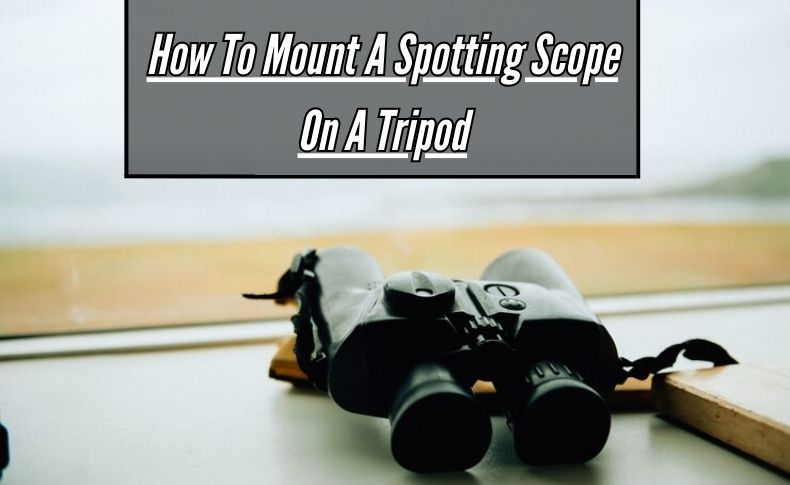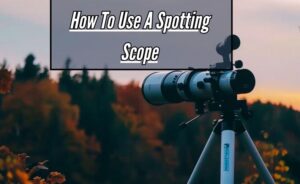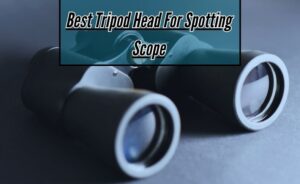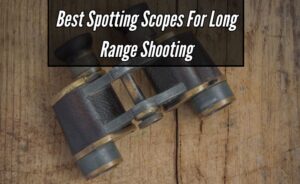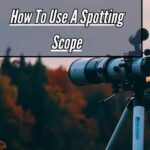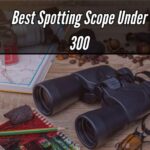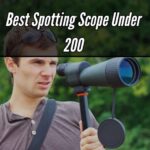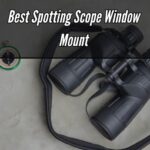Do you want to improve your spotting scope skills? Any outdoor lover or hobbyist should know how to place their spotting scope on a tripod. You may improve your viewing experience and take clear, sharp pictures of far-off things with a sturdy tripod arrangement.
How To Mount a Spotting Scope On a Tripod? Make sure the tripod is properly extended and solid before mounting a spotting scope on it. Proceed to fasten the spotting scope onto the tripod head by means of the mounting plate or adaptor. Adjust the height and angle of the scope as necessary after securing it in place. To stop any movement during observation, tighten all of the knobs.
In this guide, we’ll walk you through the simple steps to securely attach your spotting scope to a tripod, ensuring stability and precision in your observations. Whether you’re birdwatching, stargazing, or enjoying scenic landscapes, mastering this technique will undoubtedly enhance your outdoor adventures. So, let’s dive in and discover how easy it is to set up your spotting scope for optimal viewing pleasure.
Spot-On Stability: A Comprehensive Guide to Mounting Your Spotting Scope on a Tripod
For stability and clarity in your views, mounting your spotting scope on a tripod is essential. A solid setup reduces tiredness and trembling, making it easier to enjoy activities like stargazing, birding, or taking in beautiful scenery. This thorough instruction will help you make sure your spotting scope is stable.
Choosing the Right Tripod
The first step to attaining stability is choosing the right tripod. Think about things like portability, height, and weight capacity. To ensure stability, particularly in windy situations, choose a strong tripod whose weight capacity is more than the weight of your spotting scope.
For comfortable use, it is also necessary to have legs that can be adjusted and a height that fits your preferred viewing angle.
Compatible Mounting Systems
Make sure your tripod and spotting scope work together by choosing the right mounting system. The majority of spotting scopes come with a common mounting plate that uses a 1/4″-20 screw to work with tripods.
Quick-release plates or specific adapters, though, could be needed for some models. To prevent compatibility problems, double-check before making a purchase.
Proper Setup and Balancing
Setting up and balancing your spotting scope on the tripod correctly is necessary to achieve stability. In order to ensure stability on the ground, start by extending the tripod legs to an appropriate height.
Tighten the spotting scope’s strap to keep it from falling off the tripod head while enabling easy tilting and panning movements. By modifying the scope’s placement on the mounting plate, you may properly balance it and distribute the weight equally.
Adapting to Terrain:
For the best stability when assembling your tripod outside, take into account the terrain. Whenever feasible, choose a level location, and if the ground is uneven, change the leg length of the tripod to accommodate. When it’s windy, use extra stabilizing equipment like posts or sandbags for extra support.
Minimizing Vibrations
Reduce vibrations as much as possible to improve stability and observational clarity. Steer clear of touching the spotting scope too much, especially when things get serious.
When taking pictures, use a timer or remote shutter release to minimize camera shake. If you want to further reduce vibrations, especially outside, think about spending money on attachments like sandbags or tripod stabilizers.
Maintenance and Care
Regular maintenance is essential to ensure long-term stability and performance. Keep your tripod clean and free from dirt, sand, or debris that may affect its stability or functionality.
Inspect mounting hardware regularly for signs of wear or damage, replacing any worn components promptly. Lubricate moving parts as recommended by the manufacturer to ensure smooth operation.
Elevate Your View: Mastering the Art of Spotting Scope Tripod Attachment

Do you want to get more out of your spotting scope? Comprehending the tripod attachment is essential. Clear and steady views are guaranteed by a stable and compatible configuration. We’ll go over the fundamentals of tripod attachment in this tutorial so you can maximize flexibility and stability for your spotting scope excursions.
Spotting Scope Basics:
Understanding spotting scope basics is crucial before moving on to tripod attachments. These strong optical tools are well-liked by nature lovers, hunters, and birdwatchers for long-range observation.
Your spotting scope’s quality has a big impact on how you see, but mounting it properly for stability and accuracy is just as crucial.
Understanding Tripod Compatibility:
Not every spotting scope will fit every tripod, and not every tripod is made equal. Make sure a spotting scope and a tripod are compatible before making a purchase.
Verify the mounting plate size, thread compatibility, and weight capacity. Your viewing experience will be improved by a strong tripod with a fluid head that offers stability and fluid movement.
Choosing the Right Attachment Mechanism:
Usually, a mounting foot or collar that fastens to the tripod is included with spotting scopes. There are several ways to attach things, such as screw-in adapters, clamp-style mounts, and quick-release plates.
Everyone has benefits and drawbacks. While screw-in adapters offer a solid hold but can take some time to set up, quick-release plates are more convenient but may compromise stability.
Considering Portability and Weight:
For outdoor enthusiasts who must carry their gear over long distances, portability is an essential component. Tripod attachments that are small and lightweight are perfect for trekking or backpacking excursions.
But keep portability and stability in check. If stability is compromised to save weight, viewing may become unsatisfactory and images may become wobbly.
Optimizing Stability for Clear Viewing:
When using a spotting scope, stability is essential for sharp, clear views. To reduce wobbling, make sure the legs are stretched to the proper height and that your tripod attachment is firmly connected.
To further improve stability, particularly in windy circumstances, consider adding weight to the tripod’s middle column or anchoring the legs with sandbags or posts.
Maintaining Flexibility for Adjustments:
To monitor moving objects and change your viewing point, flexibility is equally as important as stability. To effortlessly track wildlife or survey wide regions, look for tripod attachments that offer seamless panning and tilting capabilities.
To increase the placement adaptability of your spotting scope, take into account add-ons like ball heads or leveling bases.
Choosing the Right Tripod for Your Spotting Scope
Choosing the right tripod for your spotting scope involves considering several essential aspects to ensure an enjoyable and hassle-free experience. Here’s a detailed look at the key factors you should keep in mind:
Material Composition:
The material composition of a tripod should be carefully considered. Typically, carbon fiber or aluminum are used to make tripods. Carbon fiber tripods have the benefit of being lightweight and vibration-resistant, but aluminum tripods are typically more robust and more reasonably priced. To select the best material for your purposes, consider your priorities in terms of durability and weight.
Leg Lock Mechanism:
Your tripod’s leg lock mechanism is a major contributor to its stability and use. Leg mechanisms on tripods are usually either twist-lock or flip-lock types. Although they are more compact in construction, twist-lock mechanisms might take longer to set up and adjust.
Conversely, flip-lock methods make adjustments quick and simple but may make the tripod bulkier. When choosing the leg lock method, take your preferences for portability and ease into account.
Height Adjustment Range:
Opt for a tripod that offers a sufficient height adjustment range to accommodate various viewing angles and preferences. Consider the maximum and minimum height settings of the tripod, as well as the availability of a center column for additional height adjustment.
A versatile height adjustment range ensures flexibility in different viewing situations, whether you’re sitting, standing, or observing from uneven terrain.
Tripod Head Compatibility:
The functionality and adaptability of your spotting scope arrangement are greatly dependent on the tripod head.
Make sure the tripod you select works with the kind of tripod head you want, whether it’s a fluid head, pan-and-tilt head, or ball head. To ensure your spotting scope is supported properly, take into account the tripod head’s weight capacity and stability.
Leg Angle Adjustability:
To suit different shooting circumstances and terrain types, look for tripods with adjustable leg angles. Tripods on uneven surfaces, including rocks, hills, or stairs, can be securely set up thanks to adjustable leg angles. With the improved stability and adaptability of this feature, your spotting scope setup will function dependably in any setting.
Quick Release System:
To make mounting and unmounting your spotting scope easy, think about getting a tripod with a fast release system. With a quick release method, you may quickly and securely connect and detach your scope without the use of tools or difficult steps.
This feature makes your outdoor experiences more convenient and helps you save time when setting up and taking down.
Warranty and Customer Support:
Finally, while buying a tripod, don’t undervalue the significance of warranty coverage and dependable customer assistance. Select a reliable brand that has a long warranty period and helpful customer support to handle any problems or questions you might have.
Long-term pleasure with your tripod investment is ensured by a dependable guarantee and first-rate customer service, giving you piece of mind.
Tripod Tactics: How to Select and Install the Perfect Support for Your Spotting Scope
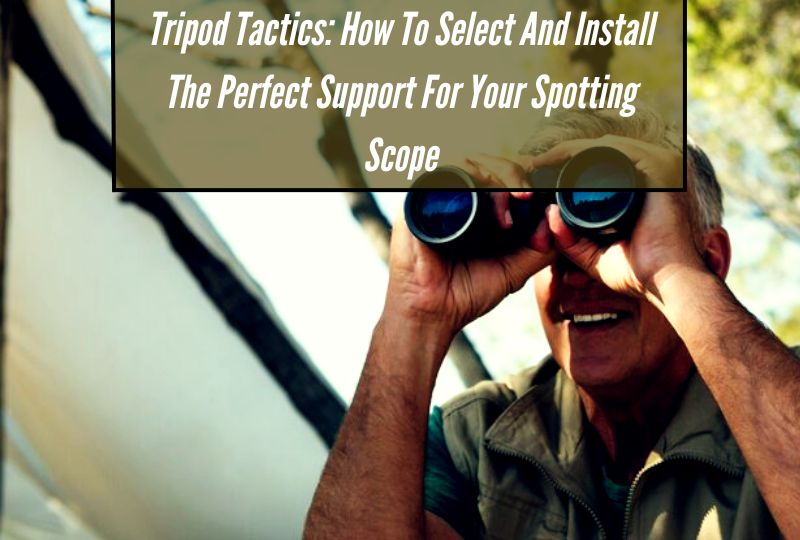
For those who like taking in the scenery or participating in outdoor pursuits like hunting and birdwatching, spotting scopes are fantastic tools. But you need to use the correct tripod with your spotting scope in order to make sure you get the most out of it. This is a guide to help you decide what to do and how to set it up.
Understanding Spotting Scope Compatibility:
It’s important to know the exact specifications of your spotting scope before choosing a tripod. Think on things like the weight, the amount of magnification, and the kind of surface you plan to use it in.
To ensure a steady and dependable setup and avoid any possible problems during observation periods, make sure your tripod and spotting scope are compatible.
Exploring Innovative Tripod Features:
When selecting a tripod for your spotting scope, explore innovative features that can enhance your viewing experience. Look for tripods with adjustable leg angles, allowing you to set up on uneven terrain without compromising stability.
Additionally, consider models with integrated bubble levels or spirit levels to ensure precise alignment and framing of your observations.
Emphasizing Ergonomic Design:
Choose tripods with ergonomic designs that put the comfort and convenience of the user first. When setting up and adjusting, look for features that offer a comfortable grip, including foam sleeves or padded leg grips.
Additionally, take into account tripods with ergonomic knobs or grips for easy and seamless adjustments when tracking moving subjects or panning across the scene.
Addressing Environmental Considerations:
Consider how well a tripod functions in various weather conditions when selecting one for outdoor use. Look for versions constructed of weather-resistant materials, such as aluminum or carbon fiber, as these materials offer sturdiness and longevity even under the most adverse circumstances.
Tripods with corrosion-resistant parts can withstand exposure to damp and humidity without losing functionality.
Maximizing Stability and Vibration Dampening:
When using a spotting scope, especially at high magnification levels, stability is crucial. To ensure a steady viewing experience, use tripods with features meant to reduce vibrations.
When selecting a model for observation sessions, look for ones with strong leg locking, sturdy center columns, and vibration-dampening features like rubberized feet or shock-absorbing materials.
Enhancing Portability and Transportability:
If you intend to use your spotting scope while trekking or traveling, pay particular attention to the tripod’s portability. Seek for portable, lightweight models that are simple to transport and assemble in the field.
In addition, think about tripods that include folding legs or quick-release mechanisms for easy setup and storage. This will free up your time so you can concentrate more on your observations and less on the logistics of your equipment.
Investing in Quality Accessories:
Consider making an investment in high-quality accessories like mounting plates, travel cases, and tripod heads to further improve your spotting scope setup.
Select tripod heads that provide for precision control over your tilt and pan movements to ensure perfect observation control. To reduce any possible swaying or instability, choose mounting plates or adapters that firmly fasten your spotting scope to the tripod.
Lock and Load: Ensuring Secure Attachment of Your Spotting Scope to the Tripod
It is essential to guarantee that your spotting scope is firmly fixed to the tripod in order to provide maximum stability and performance when making observations.
This beginner’s guide offers crucial pointers and methods to establish a strong connection between your gear, improving the precision and clarity of your outdoor adventures.
Ensuring Stability: Foundation for Clear Vision
To secure your spotting scope to the tripod effectively, it’s essential to establish a stable foundation. This foundation not only ensures the clarity of your observations but also enhances the safety of your equipment.
By understanding the importance of stability and employing suitable techniques, you can achieve a secure attachment that withstands various environmental conditions.
Exploring Attachment Mechanisms: A Closer Look
Attachment mechanisms play a crucial role in securing your spotting scope to the tripod. Understanding the intricacies of these mechanisms allows you to select the most appropriate one for your setup.
Whether it’s a quick-release plate, tension knob, or screw mechanism, each option offers unique benefits and considerations. By exploring these mechanisms in detail, you can make informed decisions to enhance the security of your attachment.
Optimizing Adjustment Options: Fine-Tuning for Precision
Achieving a secure attachment requires precise adjustments to align your spotting scope with the tripod. Various adjustment options, such as pan, tilt, and height adjustments, enable you to optimize the positioning of your equipment.
By fine-tuning these adjustments, you can minimize any potential movement or instability, ensuring a secure and steady setup for your spotting endeavors.
Enhancing Locking Mechanisms: Fortifying Your Connection
Locking mechanisms play a vital role in maintaining the stability of your spotting scope on the tripod. Whether it’s a twist lock, lever lock, or clamp system, these mechanisms provide the necessary grip to prevent slippage or loosening during use.
By enhancing these locking mechanisms through proper maintenance and care, you can fortify your connection and enjoy uninterrupted observations in any setting.
Utilizing Counterbalance Techniques: Balancing Act for Stability
Counterbalance techniques offer additional support for securing your spotting scope to the tripod, particularly in challenging conditions or uneven terrain.
By redistributing weight and balancing the load effectively, you can minimize vibrations and ensure a stable platform for your observations. Whether it’s adding counterweights or adjusting the center of gravity, these techniques provide valuable assistance in achieving secure attachment.
Maximizing Compatibility: Seamless Integration for Optimal Performance
Ensuring compatibility between your spotting scope and tripod is essential for achieving a secure attachment. Consider factors such as weight capacity, mounting options, and compatibility with accessories to maximize performance.
By selecting compatible equipment and accessories, you can seamlessly integrate your spotting scope with the tripod, enhancing both stability and functionality for your outdoor adventures.
Mounting Mastery: Unlocking the Secrets to a Solid and Reliable Spotting Scope Setup

Use our Mounting Mastery tutorial to start your quest toward mastering your spotting scope setup. Find out how to configure your equipment for crystal-clear views while maintaining stability and dependability. Developing these skills will take your outdoor experience to new levels, regardless of expertise level.
Spotting Scope Alignment Techniques:
Ensuring proper alignment between your spotting scope, tripod, and mounting head is crucial for optimal performance. Experiment with different alignment techniques, such as the “eyeballing” method or using alignment tools, to achieve precise positioning and minimize image distortion.
Innovative Mounting Solutions:
Look into creative mounting options besides standard tripods and mounting heads. For unusual viewing opportunities, take into consideration alternatives like window mounts, automobile window clamps, or specialty tree mounts. In a variety of outdoor settings, these substitute mounting options can offer flexibility and stability.
Adapting to Terrain Challenges:
Mounting your spotting scope might be difficult while navigating rough terrain or uneven environments. To improve stability on rough or uneven terrain, look for tripod models with adjustable legs or spiked feet. On difficult terrain, you might also think about utilizing ball heads or leveling bases for fast adjustments.
Integration with Technology:
You may improve convenience and functionality of your spotting scope setup by incorporating technology. Examine add-ons such as remote control systems, camera mounts, and adapters for smartphones to take pictures or record videos using your spotting scope. Your experience watching and recording can be improved by these clever technological advances.
Customizing Accessories for Comfort:
Improving comfort over long viewing sessions is crucial to stress-free outdoor enjoyment. For better handling and comfort, personalize your setup with ergonomic attachments including adjustable tripod handles, padded carrying straps, and cushioned ocular protectors. To get the most out of your time spent watching nature, put comfort first.
Fine-Tuning for Environmental Conditions:
You may greatly influence performance by adjusting your spotting scope setup based on the surrounding conditions. Test out several lens filters to improve contrast or lessen glare in direct sunshine or dimly lit environments.
In order to safeguard your equipment from bad weather and maintain dependability in any setting, you should also use lens hoods or rain protectors.
Collaborating with Fellow Enthusiasts:
Speaking with other aficionados about spotting scopes might yield insightful advice and pointers for fine-tuning your setup. Get ideas, pick up new skills, and find creative mounting solutions by participating in workshops, attending local meetups, or joining online forums. Your outdoor experience and mounting proficiency will both be improved by working with other spotting scope enthusiasts.
Maintenance and Care Tips for Spotting Scope Tripod Mounts
Spotting scope tripod mounts are essential accessories for stable and precise viewing. Proper maintenance ensures longevity and optimal performance, enhancing your outdoor experiences. Here are some practical tips to keep your tripod mounts in top condition:
Regular Cleaning:
Keep your tripod mounts clean from dirt, dust, and debris. Use a soft brush or cloth to gently remove any particles. Avoid using harsh chemicals or solvents that may damage the mount’s finish or components.
Lubrication:
Periodically lubricate moving parts of the tripod mount to prevent friction and ensure smooth operation. Use a silicone-based lubricant or grease recommended by the manufacturer. Apply sparingly to avoid attracting dust and dirt.
Check Tightness:
Make sure all connections, knobs, and screws are fastened firmly by routinely inspecting them. A loose component might cause instability and skew the image. As needed, make adjustments using a screwdriver or wrench, being cautious not to overtighten.
Storage:
Store your spotting scope tripod mount in a dry, clean place when not in use. Steer clear of extremes in temperature, moisture content, and sunlight exposure as these can cause materials to deteriorate and lose their functionality over time. For further security, think about utilizing a cover or protective case.
Avoid Overloading:
Recognize the tripod mount’s weight limit and don’t go over it. The mechanisms of the mount may be strained by overloading, which could result in early wear or failure.
Make sure any extra accessories you use are appropriate for the job and don’t exceed the suggested weight restrictions.
Transport with Care:
Take extra care not to damage your spotting scope tripod mount when you are transferring it. To cushion and safeguard against bumps and impacts during transit, use padded cases or backpacks made specifically for tripods. Any loose parts should be firmly secured to avoid them moving or disappearing.
Periodic Maintenance:
Plan frequent maintenance periods to give your tripod mount a complete inspection and cleaning. Look for wear and tear indicators like dents, scratches, and corrosion, and take quick action to fix any problems you find. For any recommended servicing or special maintenance, adhere to the manufacturer’s instructions.
Conclusion
In conclusion, spotting scope installation on a tripod is a simple procedure that improves your field of vision. Make sure the tripod you select is stable and fits the mount on your scope. After securing the scope firmly to the tripod head, correct the position for the best possible view.
To achieve the ideal stability and balance, take your time. You’ll be able to observe far-off objects steadily and clearly after it’s mounted properly. Always handle the equipment with care and make sure all setup adjustments are made on a regular basis. You may improve your outdoor experiences with sharper sights by becoming proficient with this skill via practice.
Frequently Asked Questions (How To Mount a Spotting Scope On a Tripod)
Can a camera tripod hold a spotting scope?
Yes, a camera tripod can usually support a spotting scope, but there are a few things to take into account. Spotting scopes can weigh more than cameras, so you need make sure the three-legged frame you’re using is reliable and strong enough to hold the weight.
Choose a tripod with a large weight capacity and a sturdy design. The mounting system for the spotting telescope must also be compatible with the three-legged stand. Standard 1/4″-20 thread, which is typically seen on camera tripods, is included on many spotting telescopes.
How do you carry a scope and tripod?
Care must be taken when transporting a scope and tripod to ensure their security and portability. Use specialized carrying bags made for tripods and spotting scopes to transport them. To keep your equipment safe and organized, these cases provide padding and compartments. Also included with some three-legged frames are their own carrying bags.
It’s a good idea to disassemble the tripod for compactness while carrying a scope and tripod, to fasten the scope’s eyepiece and lens covers, and to utilize any available straps or handles to equally distribute the weight.
How do you attach a telescope to a camera tripod?
To ensure stability and accurate alignment, there are a few measures to take when mounting a telescope on a camera tripod. First, make sure the mounting system on the telescope and the tripod’s head are compatible. A mounting plate for a dovetail is used on telescopes. The dovetail plate of the telescope must be connected to the tripod head using an adapter.
Verify that all connections are snugly fastened. To keep the telescope from falling off the tripodal support, it must be balanced. To guarantee stability, adjust the tripod’s legs and, if necessary, add counterweights. To finally position the telescope for the appropriate view, use the settings on the support stand.
Can you put a spotting scope on a bog tripod?
A spotting scope can be mounted on a bog tripod, but it’s important to pick the appropriate three-legged frame type. Bog tripods provide exceptional stability even on uneven surfaces because they are especially made for use in difficult outdoor conditions. In order to better grip on soft terrain, they frequently have spiky feet.
Think about the weight capacity, height, and features like quick-release mechanisms and adjustable leg angles when selecting a tripod for a spotting telescope. Make that the spotting scope’s mounting system is compatible with the tripod’s head. In particular in marshes or other marshy terrains, using a bog support stand with a spotting scope can substantially improve stability during outside observations.
What is the tripod mount screw called?
It is general knowledge that the screw used to secure a camera or other device to a tripod is referred to as the “tripod mount screw.” In order to ensure stability when taking pictures or videos, it acts as the link between the tripod and the camera.
This screw’s diameter and thread count are indicated by its standard size, 1/4″-20. Users may easily swap out equipment because of this standardized design, which is compatible with a wide range of cameras and support stands. Hence, to firmly secure your camera in position while mounting it up on a tripod and create a sturdy surface for taking clear, steady photos, use the tripod mount screw.
What are the two types of tripod mounts?
There are essentially two varieties of tripod mounts available. The most prevalent type of thread is the first, 1/4″-20. It has a 1/4-inch screw with 20 threads per inch, making a variety of cameras, camcorders, and other devices compatible with it.
The second variety is the somewhat bigger 3/8″-16 thread, which has 16 threads per inch and a 3/8″ diameter. Heavy-duty support stands and professional video equipment frequently use this type. In order to prevent mishaps or wobbling while using your tripod for creative purposes, it is crucial to select the proper tripod mount screw for your camera or other device.

